What is Australia’s Education Gap?
Education is the most important factor when looking to the future of a nation. Yet, despite Australia’s status as one of the world’s most developed countries, within its borders the Australian education system remains deeply and fundamentally divided.
Since its inception ten years ago, Teach Learn Grow has been dedicated to providing students across Australia with equal access to education opportunities, no matter their location, background or circumstances. However, ongoing barriers to education mean that many students are still falling through the education gap each year. But what exactly is the education gap, and who does it affect?
The education gap is a complex issue compounded by a combination of factors. These include geographic isolation, socio-economics and cultural background. Students most impacted by these situations, especially those living in rural and highly remote areas, as well as Aboriginal and Torres Strait Islander students, are more likely to experience educational disadvantage and fall behind in learning outcomes.
As of 2020:
1 in 4 Indigenous students in Years 5, 7 and 9 are below national minimum reading standards.
17-19% of Indigenous students struggle to achieve numeracy outcomes.
On average, only 2 in 5 students in Very Remote communities will complete Year 12 or an equivalent qualification.
Indigenous children aged 5-16 in Remote and Very Remote areas attend school on average 3-4 days per week, decreasing in high school.
Lunchtime at Yalgoo Primary School. Photo credit: Felix King Photography
In reality, the education gap is first experienced by children as young as three or four years old. The differences from their non-disadvantaged peers at this age quickly compound in a domino effect that widens the divide as students progress through school. In 2018 it was recorded that on average, Indigenous children across Australia were about 5% less likely to be enrolled in an early childhood education program than non-Indigenous children. Inequalities between groups continue to expand over time so that by high school only 38% of Indigenous Australians from Very Remote areas will complete Year 12, compared to 85% of their metropolitan peers.
These comparative statistics cannot be attributed to any single factor, making the education gap difficult to both understand and prevent from recurring. There are many barriers to education facing young people from remote backgrounds, including restricted transport options- which can result in lowered attendance,- lack of community support for higher education, limited teaching resources, higher teacher turnover, and difficulty accessing digital technology.
It is important to recognise the individual circumstances facing each student are nuanced and different from one another. To improve education outcomes it is necessary to not only provide more resources, but create a culture where educational and emotional support for students can be accessed throughout the community. As the adage says, it takes a village to raise a child, and it is necessary to consider a combination of factors to begin to understand the day-to-day reality of the education gap. A video called Swimming the River, linked here, is a useful summary of the cycle of disadvantage many Indigenous students find themselves a part of and acknowledges the difficulties that come in trying to break free.
Yalgoo coordinator Nicole running a Saplings arts project. Photo credit: Felix King Photography
Recently, the inequality between regional and metropolitan schools’ access to technology and resources has become even more pronounced. The gradual trend towards online schooling has been ongoing for the last decade. However the COVID-19 pandemic has resulted in a ripple effect that has seen an increased rate in this transition. While digital learning has been successful in urban environments, the limited capabilities of many remote schools have led to an increasing digital divide. Students in rural communities are often unable to complete online homework outside of school hours, and even well-equipped schools are restricted by slow internet connections and internet outages that can last weeks.
While TLG and other organisations work to provide resources, volunteers and transport for students in disadvantaged situations, the fight for educational parity is far from won. Since 2008 the Australian Federal Government has supported the National Agreement on Closing the Gap, which is a strategy that aims to improve the life outcomes of Aboriginal and Torres Strait Islander people through increasing standards of health, education, employment, justice, housing, cultural recognition and more. However, while on the whole educational standards are rising and new education programs highlighting Aboriginal and Torres Strait Islander culture and history are being introduced, there has also been declining attendance at regional schools in certain parts of Australia and the education gap persists.
Students from Pia Wadjarri Remote Community School learning new science skills.
If given a chance to succeed, if provided with strong support systems and sufficient resources, students from all backgrounds have the ability to break out of the cycle of disadvantage to pursue dreams of higher education. Bridging the education gap is a challenging and an ongoing process. Nevertheless, it begins with all Australians learning about the current inequalities within the education system and listening to the voices of those with knowledge and insight, such as community leaders and Elders. It is the responsibility of communities across Australia to be supportive and generous to those who have been disadvantaged, and to believe that children from all backgrounds have the potential to achieve great things if given an equal opportunity.
This story was written by TLG Public Relations Officer, Hannah Landwehr.
All statistics used can found from the Closing the Gap Report 2020.




